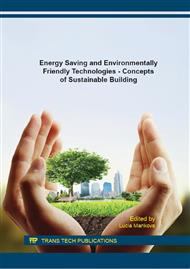[1]
Fraunhofer ISI, Study on the energy savings potentials in EU Member States, Candidate Countries and EEA Countries final report, Fraunhofer-Institute for Systems and Innovation Research (Fraunhofer ISI; Coordinator), Karlsruhe/Grenoble/Rome/Vienna/Wuppertal, (2009).
DOI: 10.2172/1172118
Google Scholar
[2]
A. Stephan, R.H. Crawford, K. De Myttenaere, A comprehensive assessment of the life cycle energy demand of passive houses, Appl Energy, 112 (2013), 23–34.
DOI: 10.1016/j.apenergy.2013.05.076
Google Scholar
[3]
H. -R. Kymäläinen, A. -M. Sjöberg, Flax and hemp fibres as raw materials for thermal insulations, Build Environ, 43 (2008), 1261-1269.
DOI: 10.1016/j.buildenv.2007.03.006
Google Scholar
[4]
Environmental management—life cycle assessment—principles and framework (ISO 14040: 2006). International Organization for Standardization (ISO), Geneva, (2006).
DOI: 10.1065/lca2005.03.001
Google Scholar
[5]
Environmental management—life cycle assessment—requirements and guidelines (ISO 14044: 2006). International Organization for Standardization (ISO), Geneva, (2006).
DOI: 10.3403/30290345
Google Scholar
[6]
Sustainability of construction works – Environmental product declarations – Core rules for the product category of construction products, European Committee for Standardization (CEN), Brussels, (2012).
DOI: 10.3403/30259256u
Google Scholar
[7]
GaBi Software - to drive product sustainability! http: /www. gabi-software. com/software/gabi-software/, PE International, last access 11th May (2015).
Google Scholar
[8]
Professional Database. http: /www. gabisoftware. com/databases/gabi-databases/professional/, PE International, last access 11th May (2015).
Google Scholar
[9]
Ecoinvent v2. 0. Swiss Centre for Life Cycle Inventories, Switzerland, (2007).
Google Scholar
[10]
L. Barnthouse, J. Fava, K. Humphreys, R. Hunt, L. Laibson, S. Noesen et al., Life cycle impact assessment: the state-of-the-art, SETAC Press, Pensacola, (1998).
Google Scholar
[11]
Statistical Yearbook of the Czech Republic - 2014, Czech Statistical Office (CZSO), Prague, (2011).
Google Scholar
[12]
M. Kavka, Normativy pro zemědělskou a potravinářskou výrobu: technologické, technické a ekonomické normativní ukazatele, Institute of Agricultural Economics and Information, Prague, (2006).
Google Scholar
[13]
M. Kavka, Normativy zemědělských výrobních technologií: pěstební a chovatelské technologie a normativní kalkulace (práce, materiál, energie, náklady, produkce, tržby, příspěvek na úhradu fixních nákladů), Institute of Agricultural Economics and Information, Prague, (2006).
Google Scholar
[14]
N. P. J. Dissanayake, Life Cycle Assessment of Flax Fibres for the Reinforcement of Polymer Matrix Composites, University of Plymouth, (2011).
Google Scholar


